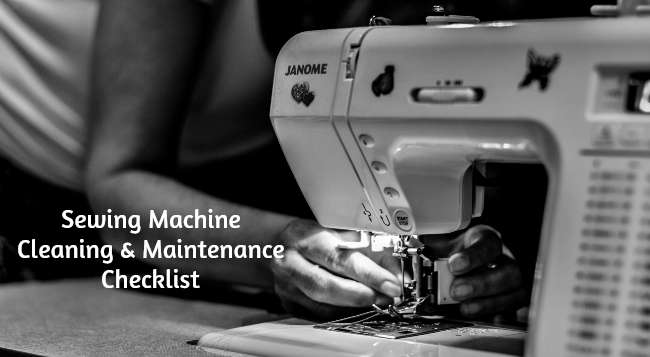Whether you use it for home use or professional use, taking proper care of your sewing machine is very important as it helps improve the longevity of the machine.
Generally, the electric appliances need occasional cleaning and care, especially when they are not used regularly.
The same goes with the electric sewing machines as well.
So, in this article, I will walk you through the sewing machine care and maintenance checklist that I have learned from an authorized service technician.

How to Properly Take Care of Your Sewing Machine?
1. Cover Your Sewing Machine, When not in Use
After each use, cover the sewing machine using a dust cover or hard case.
If you leave it open, when not in use for extended periods, then it can accumulate dust inside, thereby reducing the efficiency of the sewing machine.
It is also good if you could occasionally perform dusting inside the bobbin case with an unused tooth brush or cosmetic brush by unplugging it.
2. Remove Lint Using Compressed Air
After you finished with stitching of your clothes and won’t need your machine until the next few days/weeks, give your sewing machine a proper cleaning.
This is because the lint may build-up after using the machine for a period of time.
In order to remove lint, you can try the compressed air that will also remove any thread from the feed dogs, bobbin area and the tension discs.
While using the compressed air, ensure that you keep the blower nozzle at least 4 inches away from the machine to prevent any moisture from entering into the machine.
3. Replace the Old Needles with New Ones Regularly
Changing the needle regularly is one of the most important tasks in the sewing machine care checklist.
Because, it is the first thing you will forget replacing and over time, these needle will become dull and may interfere with your stitching efficiency.
A damaged needle is also responsible for skipped stitches, looped threads, fabric pulls and could ultimately damage your sewing machine.
According to the experts, one should change the needle every time you finish a project or use the needle for 8 hours, whichever is earlier.
A needle should also be changed according to the type of fabric and its weight.
4. Wipe the Machine After Each Use
After each use, it is advised to unplug and clean the sewing machine using a rag.
Once done with the machine, also ensure that you clean the bobbin case with the same rag to remove any dust or lint build-up that could decrease the stitching efficiency of the machine.
5. Regularly Oil the Sewing Machine
Oiling is one thing that should be part of your sewing machine care routine.
Like any other mechanical devices, the sewing machine also requires regular oiling so that the internal parts can move smoothly.
This will also bring down the noise that the machine makes while running.
However, you cannot use just any type of oil available in the market as they could stain your garments.
You can find separate sewing machine oils both online and offline. Just add couple of drops and you’re good to go.
And, don’t forget to run a few stitches on a scrap fabric after you’ve applied the oil. This helps in removing any extra oil (just in case).
Note: There are some self-lubricating sewing machine models in the market and they doesn’t require you to add any oil for lubrication. So, read your user’s manual to find the features of your machine and then proceed further.
6. Clean the Machine One Part at a Time
Unlike the traditional sewing machines, the automatic models come with lot of internal parts and you could get confused with the srewing and fixing.
So, check your sewing machine’s user manual for instructions on how to clean different parts of the machine.
Also, make sure that you clean one part of the machine at a time. And only after fixing it back to its place, move to the cleaning of next part.
This way you can avoid any confusion and can clean your machine properly.
7. Let the Authorized Technician Repair the Machine
You can always contact the authorized technicians in case if your sewing machine needs any repair works.
Never let an unauthorized service men repair your machine as it could make your warranty void.
He/she may not have worked on different brands of sewing machines.
Also, some problems can only be solved by the experienced professionals as they’re trained specially by the manufacturers.
They know exactly how to adjust the timing and tension of a machine.
You can find the official customer care number on your user’s manual, external packing box or by visiting the brand’s official website.
8. Annual Servicing of the Machine
In order to get the maximum benefit out of your sewing machine, it is highly advised to take proper care of its maintenance.
Give your machine a complete professional service once an year from the expert technicians (brand-specific) to keep it in perfect working condition.
Final Word
Before taking any decision, whether it is cleaning, oiling or repairing the sewing machine, first carefully read the user’s manual that came with your machine.
You’ll find all the details like the features, how to clean it, how to remove the parts, what type of oil to be used etc…
That way, you can get the best out of your sewing machine after cleaning and regular maintenance.
